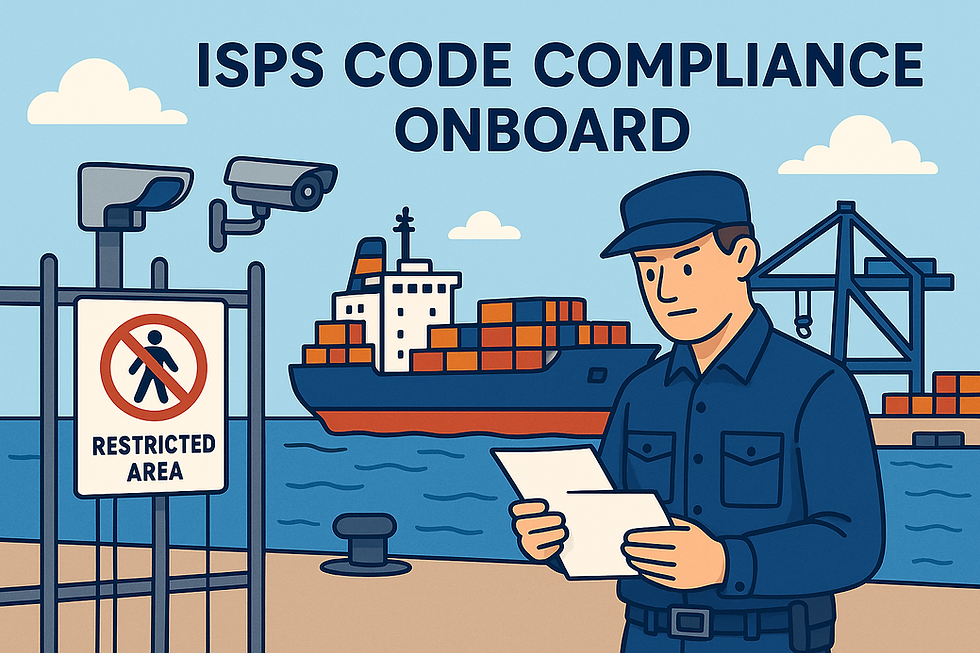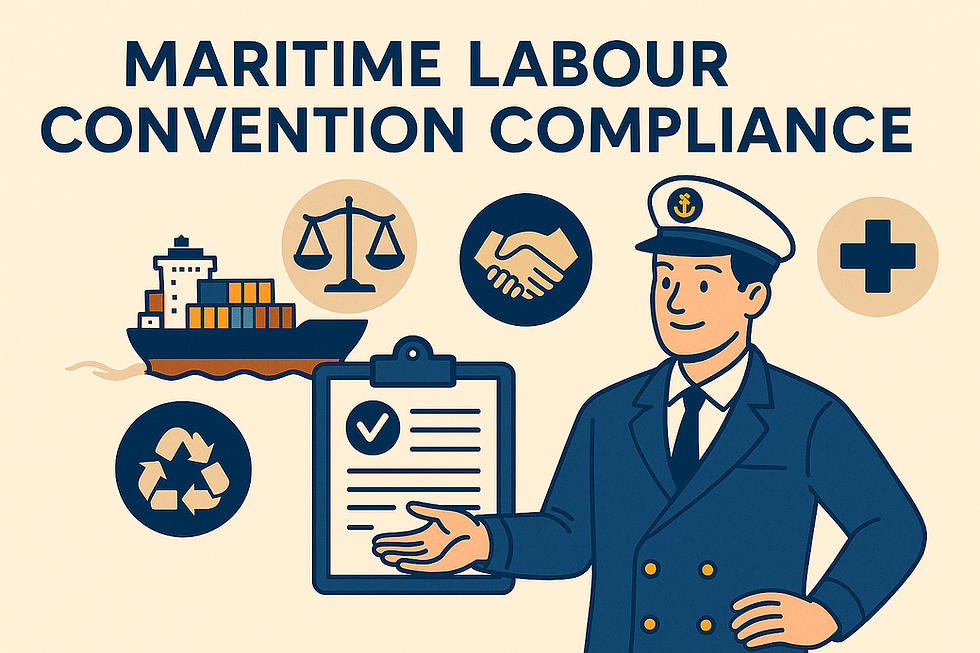Environmental Liability at Sea: How to Stay Compliant and Insured When Things Go Wrong 🌊⚖️
- Davide Ramponi

- 22. Juli
- 5 Min. Lesezeit
My name is Davide Ramponi, I’m 20 years old and currently training as a shipping agent in Hamburg. On my blog, I take you with me on my journey into the fascinating world of shipping. I share my knowledge, my experiences, and my progress on the way to becoming an expert in the field of Sale and Purchase – the trade with ships.

When we talk about maritime compliance, topics like MARPOL, SOLAS, and ballast water management often come to mind. But there’s another layer of responsibility that affects every shipowner—environmental liability and insurance.
What happens when a ship spills oil near a protected coastline? What if cargo containing hazardous materials leaks into international waters? And who pays when a wrecked vessel threatens the local marine ecosystem?
That’s where environmental liability laws and insurance coverage step in. These frameworks don’t just determine how environmental damage is handled—they shape who bears the cost, and how much protection is legally required before a vessel even leaves port.
So today, we’ll explore the legal foundations, insurance obligations, real-world risk scenarios, and compliance strategies every maritime stakeholder should know.
Let’s dive in. 🌍⚓
What Is Maritime Environmental Liability? 📜🌱
Environmental liability in shipping refers to the legal obligation of shipowners and operators to prevent, mitigate, and—if necessary—compensate for environmental damage caused by maritime operations.
This liability is grounded in international conventions, national laws, and regional frameworks. The focus is on incidents involving:
Oil spills 🛢️
Chemical or hazardous cargo releases ☠️
Garbage or sewage discharge 🧴
Air emissions or ballast water pollution 🌫️
⚖️ Key Legal Instruments:
MARPOL Convention (1973/78)Sets pollution prevention standards for oil, sewage, garbage, and air emissions.
CLC – Civil Liability Convention (1969, amended)Holds shipowners liable for oil pollution damage caused by persistent oil tankers. Requires insurance cover.
BUNKER Convention (2001)Covers liability and insurance for pollution from bunker fuel.
Nairobi WRC (2007)Relates to the removal of wrecks that pose environmental risks.
HNS Convention (not yet in force)Targets hazardous and noxious substances carried by sea.
🧠 Takeaway: If your vessel causes environmental damage—even accidentally—you could be held financially and legally responsible. That’s why proper coverage and planning are non-negotiable.
What Insurance Coverage Is Required—and Why? 🛡️📄
To manage these risks, shipowners must hold adequate marine insurance, particularly for environmental liability. Here’s what that looks like:
🔹 1. Protection & Indemnity (P&I) Insurance
P&I Clubs provide third-party liability insurance for:
Pollution clean-up and fines 💸
Environmental damage claims 🐬
Wreck removal and cargo recovery 🧺
Legal defense costs ⚖️
✅ Most ocean-going vessels are covered by an International Group P&I Club—11 major clubs that cover over 90% of the world fleet.
🔹 2. Compulsory Certificates (CLC/BUNKER/Nairobi)
To operate in certain jurisdictions or enter ports, vessels must carry:
CLC Certificate (for oil tankers >2,000 GT)
Bunker Convention Certificate (for ships >1,000 GT)
Wreck Removal Certificate (per Nairobi WRC)
These confirm that the vessel has valid insurance to cover liability limits set by the conventions.
🔹 3. Environmental Damage Endorsements
Some operators go further by obtaining additional policies for:
Environmental impairment liability (EIL)
Charterer’s liability for pollution
Cyber-pollution or sabotage-triggered loss
📋 Tip: Always check what’s excluded from basic P&I coverage. For example, fines for willful misconduct or pollution during illegal operations may not be insured.
Environmental Risks and Real-World Scenarios 🧯🛳️
Even with the best intentions, shipping operations carry environmental risks. Here are some typical liability-triggering events:
🌊 1. Oil and Fuel Spills
Source: Groundings, collisions, tank overflows, bunkering accidents.
Impact: Contamination of marine life, coastal damage, cleanup costs.
Liability: Strict and automatic under CLC and Bunker Convention.
Real case:
In 2020, a Japanese bulk carrier ran aground off Mauritius, spilling over 1,000 tonnes of fuel oil. The cleanup cost tens of millions, with liability covered under CLC and P&I policies.
⚗️ 2. Hazardous Cargo Leaks
Source: Chemical leaks from containers or tankers.
Impact: Human health risk, fishery damage, air and water contamination.
Liability: Governed under HNS Convention (when in force), local laws, or contractual clauses.
Real case:
A fire aboard a container ship in 2021 exposed port workers to hazardous vapors due to undeclared chemicals. Authorities launched a criminal and civil investigation. The cargo owner’s liability insurer was also drawn into the case.
⚓ 3. Abandoned or Sunken Wrecks
Source: Total loss incidents or vessels left by insolvent owners.
Impact: Navigation hazard, pollution from residual oils, legal conflict over wreck removal.
Liability: Nairobi WRC obliges removal and insurance-backed coverage.
⚠️ Reminder: If your ship sinks in coastal waters and creates an environmental hazard, you’re on the hook for its safe removal—whether or not you have the funds available.
Best Practices for Compliance and Risk Management 🧭✅
A proactive approach is the best defense against environmental liability. Here’s how responsible shipowners reduce their risk:
✔️ 1. Maintain Valid Certificates and Coverage
Ensure all CLC, Bunker, and WRC certificates are onboard and up to date.
Review P&I coverage annually—especially before voyages in sensitive zones like the Arctic, Caribbean, or EU coasts.
✔️ 2. Invest in Spill Prevention and Response
Keep SOPEP kits visible and fully stocked ⚙️
Train crew in spill response and emergency drills 🛟
Schedule equipment inspections and bunker audit logs regularly
✔️ 3. Understand Regional Variations
EU ports may impose wider liability than IMO conventions
U.S. laws (like the Oil Pollution Act) go beyond CLC limits and impose strict cleanup standards
Port States may demand proof of financial security for lay-up or hazardous cargoes
📌 Tip: Maintain a “compliance map” for your fleet showing local insurance and liability requirements by region.
✔️ 4. Cooperate with P&I Claims Teams
In case of an incident, notify your P&I Club immediately
Document everything: logbooks, photos, witness statements 📸
Appoint a single point of contact for communications with responders and legal teams
🧠 Best Practice: Many shipowners appoint an Environmental Compliance Officer onboard or at HQ to centralize planning, audits, and liaison with insurers.
Case Studies: Claims, Compensation & Lessons Learned 📚💡
Let’s look at how environmental liability and insurance play out in practice.
🛢️ Case 1: Crude Oil Spill in South America
A tanker suffered a ruptured pipe during offloading. Around 500 tonnes of crude oil leaked into a mangrove area, prompting:
Port closure for 10 days
$12 million in cleanup and environmental monitoring
Multiple lawsuits from fishing communities
P&I Club paid most damages, but owner paid a deductible due to negligence claims (poor pipe maintenance). Authorities required vessel owner to fund ecosystem restoration over 3 years.
⚓ Case 2: Wrecked Container Ship Near Coral Reefs
A feeder vessel struck a reef and partially sank in a protected area. The hull contained residual fuel, and the cargo included paint chemicals. The ship:
Was uninsured for wreck removal
Had expired Nairobi WRC certificate
Was eventually removed under government contract—with costs recovered from the shipowner’s assets
Lesson:
Without proper certificates, owners can lose control of salvage decisions—and face enormous out-of-pocket expenses.
🧴 Case 3: Plastic Pellet Spill
A bulk carrier carrying plastic pellets (nurdles) lost part of its cargo during stormy weather. The pellets washed up on local beaches, sparking public outrage and environmental fines.
Claim outcome:
Pollution response cost: $1.2 million
Fines from local marine agency
Loss of charter agreement and cargo claims
P&I coverage handled cleanup, but the cargo owner’s insurer shared liability due to packaging issues.
Conclusion: Protecting the Sea—and Your Bottom Line 🌐⚓
Environmental liability in shipping isn’t just a legal formality—it’s a financial reality. Whether it’s a minor leak or a major disaster, the cost of environmental damage can be enormous.
But with the right legal awareness, valid insurance coverage, and sound risk management, shipowners can navigate these risks responsibly and confidently.
Let’s recap:
Maritime environmental liability is governed by conventions like CLC, MARPOL, and BUNKER 📘
P&I insurance is essential—but not all-inclusive 🛡️
Shipowners should maintain certificates, train crew, and know regional rules 🌍
Case studies show how quick action and compliance reduce liability and losses 🔍
Have you ever encountered environmental liability challenges? How do you manage compliance and insurance for your fleet?
💬 Share your thoughts in the comments — I look forward to the exchange!





Kommentare